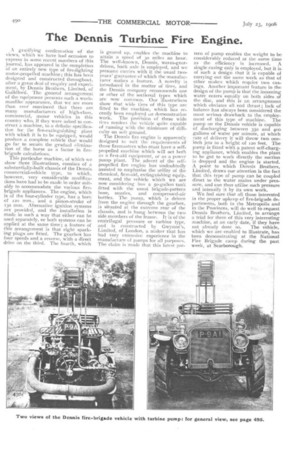The Dennis Turbine Fire Engine.
Page 6

If you've noticed an error in this article please click here to report it so we can fix it.
A gratifying confirmation of the views, which we have had occasion to express M some recent numbers of this journal, has appeared in the completion of an entirely new type of fire-fighting motor-propelled machine; this has been designed and constructed throughout, after a great deal of enquiry and experiment, by Dennis Brothers, Limited, of Guildford. The general arrangement of the equipment presents such a workmanlike appearance, that we are more than ever convinced that there are many manufacturers of high-class, commercial, motor vehicles in this country who, if they were asked to construct a machine, to a definite specification for the fire-extinguishing plant with which it is to be equipped, would produce a complete vehicle that would go far to secure the gradual elimination of the horse as a factor in firebrigade calculations.
This particular machine, of which we show three illustrations, consists of a substantially-built chassis of the Dennis commercial-vehicle type, to which, however, very considerable modifications have had to be made in order suitably to accommodate the various fire.. brigadeappliances. The engine, which is of the four-cylinder type, has a bore of 120 min., and a piston-stroke of 130 mm. Alternative ignition systems are provided, and the installation is made in such a way that either can be used separately, or both systems can be applied at the same time; a feature of this arrangement is that eight sparking plugs are fitted. The gearbox has four speeds and a reverse, with a direct drive on the third. The fourth, which is geared up, enables the machine to attain a speed of 30 miles an hour. The well-known, Dennis, worm-geardriven, back axle is employed, and we presume carries with it the usual twoyears' guarantee of which the manufacturer makes a feature. A novelty is introduced in the matter of tires, and the Dennis company recommends one or other of the sectional types which are now common. Our illustrations show that wide tires of this type are fitted to the machine, which has recently been employed on demonstration work. The provision of these wide tires renders the vehicle quite capable of running with the minimum of difficulty on soft ground.
The Dennis fire engine is apparently designed to suit the requirements of those firemasters who must have a selfpropelled machine which will act both as a first-aid equipment, or as a power pump plant. The advent of the selfpropelled fire engine has undoubtedly assisted to emphasise the utility of the chemical, first-aid, extinguishing equip_ merit, and the vehicle which we are now considering has a so-gallon tank fitted with the usual brigade-pattern hose, nozzles, and compressed-air bottles. The pump, which is driven from the engine through the gearbox, is situated at the extreme rear of the chassis, and is hung between the two side members of the frame. It is of the centrifugal pressure or turbine type, and is constructed by Gwynne's, Limited, of London, a maker that has had very extensive experience in the manufacture of pumps for all purposes. The claim is made that this latest pat tern of pump enables the weight to be considerably reduced at the same time as the efficiency is increased. A single casing only is employed, but it is of such a design that it is capable of carrying out the same work as that of other makes which require two casings. Another important feature in the design of the pump is that the incoming water enters equally on both sides of the disc, and this is an arrangement which obviates all end thrust ; lack of balance has always been considered the most serious drawback to the employment of this type of machine. The pump on the Dennis vehicle is capable of discharging between 350 and 400 gallons of water per minute, at which rate of delivery it will throw two oneinch jets to a height of 120 feet. The pump is fitted with a patent self-charging appliance, which enables the plant to be got to work directly the suction is dropped and the engine is started. A point to which Dennis Brothers, Limited, draws our attention is the fact that this type of pump can be coupled direct to the water mains under pressure, and can thus utilise such pressure and intensify it by its own work.
We feel sure that all those interested in the proper upkeep of fire-brigade departments, both in the Metropolis and in the Provinces, will do well to request Dennis Brothers, Limited, to arrange a trial for them of this very interesting machine, at an early date, if they have
not already done so. The vehicle, which we are enabled to illustrate, has been demonstrating at the National Fire Brigade camp during the past week, at Scarborough.




















